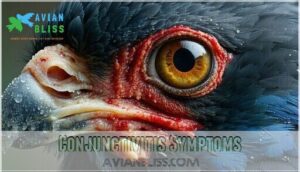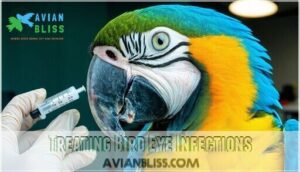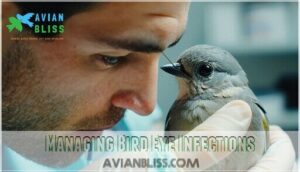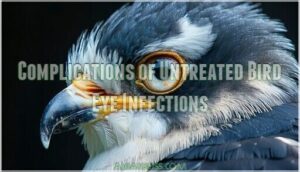This site is supported by our readers. We may earn a commission, at no cost to you, if you purchase through links.
 Treating a bird’s eye infection begins with spotting the signs—think redness, swelling, crusty discharge, or excessive blinking.
Treating a bird’s eye infection begins with spotting the signs—think redness, swelling, crusty discharge, or excessive blinking.
You’ll want to visit an avian vet for a diagnosis since the cause could be bacterial, viral, fungal, or even a vitamin A deficiency.
Treatment typically includes vet-prescribed antibiotics, antiviral or antifungal drops, and sometimes anti-inflammatory medication.
Keep your bird’s cage clean and stress-free while ensuring it has proper hydration and a balanced diet.
Avoid home remedies—they can do more harm than good.
A sharp eye and quick response can help your bird recover faster, and there’s plenty more to learn about preventing future infections.
Table Of Contents
- Key Takeaways
- Recognizing Bird Eye Infections
- Causes of Bird Eye Infections
- Diagnosing Bird Eye Infections
- Treating Bird Eye Infections
- Managing Bird Eye Infections
- Preventing Bird Eye Infections
- Parrot Eye Infection Treatment
- Complications of Untreated Bird Eye Infections
- Recovery and Prognosis
- Frequently Asked Questions (FAQs)
- What to do if a bird has an eye infection?
- How do you treat eye disorders in birds?
- How do you treat conjunctivitis in birds?
- How do you treat a parrot eye conjunctivitis?
- How do you treat a swollen bird eye?
- How to treat a bird’s eye infection at home?
- What is the best eye ointment for birds?
- What antibiotic is good for birds eyes?
- How do you know if a bird has conjunctivitis?
- What does a bird eye infection look like?
- Conclusion
Key Takeaways
- Watch for early signs like redness, swelling, or discharge, and clean with sterile saline while keeping the environment clean.
- Consult an avian vet quickly for proper diagnosis and treatment with antibiotics, antifungals, or antivirals as needed.
- Provide a balanced diet rich in vitamin A and keep the cage free of irritants to support recovery and prevent future infections.
- Avoid home remedies and follow vet-prescribed treatments to prevent long-term complications like blindness or systemic infections.
Recognizing Bird Eye Infections
You can spot bird eye infections by watching for telltale signs like redness, swelling, or unusual discharge. Recognizing these early can help prevent serious complications and keep your bird healthy.
Spot bird eye infections early by monitoring for redness, swelling, or discharge—quick action prevents complications and ensures a healthy, happy bird.
Conjunctivitis Symptoms
Recognizing conjunctivitis in birds isn’t hard if you know the signs.
Look for eye discharge, often thick and crusty, paired with swelling around the eyelids. Facial swelling is another red flag, especially when combined with excessive tearing or eye redness.
If your bird’s frequently blinking, squinting, or keeping their eyes closed, don’t brush it off—it could mean discomfort or irritation.
Acting early can prevent bigger problems. Keep a first aid kit handy, include sterile saline to flush irritated eyes, and consult your vet if symptoms persist.
Early attention makes all the difference for your feathered friend.
Common Bird Eye Infections
Birds face various eye infections like pink eye (conjunctivitis), often caused by bacterial or viral infections.
Conditions like corneal ulcers and blepharitis need proper bird eye infection treatment.
Hypovitaminosis A can trigger infections too.
Issues like uveitis (internal eye inflammation) may develop unexpectedly.
Preventive care, clean habitats, and a healthy diet keep eye infections at bay, ensuring happier and healthier birds.
Parrot Eye Infection Signs
Does your parrot seem out of sorts? Watch for these eye problem clues:
- Eye discharge: White, tan, or crusty buildup around the eyes or nostrils may signal trouble.
- Redness and swelling: Puffy eyelids or facial swelling often indicate conjunctivitis or infections.
- Squinting behavior: Closed or squinting eyes suggest irritation or discomfort.
- Excessive tearing: Cloudy eyes or extra tears might hint at underlying parrot eye problems needing vet care.
Causes of Bird Eye Infections
Bird eye infections happen for many reasons, including bacteria, viruses, fungi, or even vitamin deficiencies. Injuries, dust, or other irritants can also lead to sore, swollen, or irritated eyes.
Bacterial Infections
Bacterial infections like Chlamydia or Mycoplasma can lead to bacterial conjunctivitis, causing redness, swelling, and discharge.
These culprits are treated with ocular antibiotics, such as topical or oral options.
With distemper infections or resistant bacterial strains, treatment may take longer.
Keep your bird’s environment clean to prevent recurrence.
Prompt use of antibiotics guarantees faster recovery from Mycoplasma conjunctivitis, so stay proactive—your vigilant care makes all the difference in their health.
Viral Infections
While bacteria get much attention, viruses pack their own punch when targeting your bird’s eyes. Avian Poxvirus and Infectious Bronchitis are the main culprits behind Viral Conjunctivitis in pet birds.
These microscopic troublemakers cause the same redness and discharge you’d see with bacterial infections, but they need different treatment approaches.
Here’s what makes viral eye infections tricky:
- Symptoms appear 10-14 days after your bird catches the virus
- Avian-Specific Antivirals are required for proper treatment
- Secondary Infections often develop without prompt veterinary care
Fungal Infections
While viruses pose one threat, fungal infections present another serious concern for your feathered friend.
Candida and Aspergillus are common culprits causing whitish discharge and eye swelling.
These organisms thrive in humid conditions, making Environmental Control essential.
Antifungal medications like itraconazole treat localized infections, though Antifungal Resistance can complicate treatment.
Without proper care, simple fungal infections may progress to Systemic Mycosis, threatening your bird’s overall health.
Vitamin a Deficiency
Beyond the obvious culprits like bacteria and fungi, vitamin A deficiency stands as a silent threat to your bird’s eye health.
This nutritional gap weakens your feathered friend’s immune system and creates perfect conditions for infections to take hold. When birds lack adequate vitamin A, their vision problems multiply, and their eyes become vulnerable to conjunctivitis and corneal ulcers.
A seed-heavy diet often leads to vitamin A deficiency.
Your bird diet needs consistent Vitamin A Sources to prevent these issues:
- Fresh vegetables: Carrots, sweet potatoes, and leafy greens provide natural vitamin A
- Deficiency symptoms: Watch for eye discharge, swelling, and respiratory infections
- Dietary supplementation: Bird-specific vitamin A supplements help bridge nutritional gaps
- Prevention: Regular vet checkups catch early warning signs before serious complications develop
Eye Trauma
How do collision injuries happen so easily with curious birds? Your feathered friend’s exploratory nature makes cage safety essential.
Sharp objects, protruding wires, and unsafe toys cause eye trauma leading to corneal ulcers, scratches, and bleeding. Scratch prevention starts with inspecting perches and removing hazardous items.
When eye injuries occur, gentle trauma treatment with saline solution provides immediate relief.
Diagnosing Bird Eye Infections
When you suspect your bird has an eye infection, you’ll need a veterinarian to perform specific tests to identify the exact cause and severity.
Your vet will examine your bird’s eyes, check its medical history, and run diagnostic tests like tear production measurements and eye pressure checks to create the right treatment plan.
This process will help determine the best course of action for your bird’s specific condition, ensuring it receives the appropriate care for its eye infection.
Physical Examination
When your bird shows eye problems, a thorough physical examination reveals key details.
Your veterinarian will conduct a pupil examination to check responses and discharge analysis to identify infection types. Swelling assessment around the eye area and head examination help pinpoint issues.
This palpebral evaluation guides proper treatment decisions.
- Eye examination includes checking pupil size, shape, and light response
- Discharge analysis determines if secretions are bacterial, viral, or fungal
- Swelling assessment measures inflammation severity around eye tissues
- Veterinarian diagnosis combines visual findings with clinical expertise
History and Environment Assessment
After completing the physical examination, your vet will gather your bird’s medical history and assess their environment.
This detective work reveals potential triggers for eye infections.
Key areas they’ll explore include:
- Dietary History: Recent food changes or nutritional gaps
- Hygiene Practices: How often you’re doing cage cleaning
- Environmental Toxins: Exposure to smoke, chemicals, or fumes
- Recent Changes: New toys, perches, or household products
- Exposure Risks: Contact with other birds or outdoor elements
Tear Test
The tear test procedure measures your bird’s natural eye moisture using special filter paper.
Your avian vet places strips near the eye during examination, checking if tear production falls within the normal tear range.
The Schirmer tear test provides tear test accuracy for proper bird eye infection diagnosis.
Interpreting results helps determine if dryness contributes to eye problems before fluorescein staining.
Fluorescein Staining
Fluorescein staining serves a critical staining purpose in bird eye infection diagnosis, revealing hidden corneal damage that’s invisible to the naked eye.
Your avian vet applies fluorescein dye during the eye examination, then uses cobalt blue light to illuminate any injuries.
The procedure details are straightforward: a few drops of dye, followed by immediate examination under special lighting.
Interpretation errors can occur if you rush the process—damaged areas may need several minutes to show distinct green fluorescence.
While fluorescein staining excels at detecting corneal ulcers and scratches, it has staining limitations.
Alternative dyes exist, but this veterinary care standard remains most reliable for surface damage detection.
Intraocular Pressure Test
When your avian vet performs an intraocular pressure test, they’re checking for glaucoma and other serious eye conditions that could threaten your bird’s vision.
This avian ophthalmology procedure helps detect problems early:
- Glaucoma Detection prevents permanent blindness
- Test Procedure uses specialized equipment calibration
- Pressure Interpretation guides treatment decisions
The eye examination requires careful anesthesia risks consideration for your bird’s safety.
Treating Bird Eye Infections
When you notice signs of an eye infection in your bird, you’ll need to start treatment quickly to prevent serious complications like blindness.
Your veterinarian will prescribe specific medications based on the type of infection, which may include antibiotic drops, antifungal treatments, or anti-inflammatory drugs to help your feathered friend recover.
Antibiotics for Bacterial Infections
When bacterial infections strike your bird’s eye, antibiotics step up as the frontline treatment.
Your vet will likely prescribe topical antibiotics like tetracycline or broad-spectrum antibiotics such as fluoroquinolones for effective eye infection treatment.
Both topical and oral antibiotics tackle the bacterial infection from different angles, and you should watch for antibiotic side-effects like digestive upset or behavioral changes.
For specific needs, consider tetracycline products for birds, and follow dosage instructions precisely—improper use can lead to antibiotic resistance, making future treatments less effective.
Complete the full course even if symptoms improve early.
Antiviral Medication
When viral infections strike your bird’s eyes, antiviral medication can turn the tide.
Avian antivirals like idoxuridine and trifluridine target specific viral processes effectively.
However, dosage guidelines are critical—acyclovir’s poor bioavailability makes it unsuitable for first-line treatment.
Resistance development remains a concern with prolonged use.
Most antiviral eye treatments involve off-label use since few are specifically approved for birds.
Your vet may combine supportive therapies with antiviral medication to boost effectiveness and reduce complications during treatment.
Antifungal Medication
When antiviral treatments don’t solve the problem, fungal infections might be the culprit.
These stubborn invaders require targeted antifungal medication to clear up your bird’s eye troubles. Itraconazole use remains the gold standard for systemic infections, while fluconazole offers another reliable option.
Here’s what you need to know about treating fungal eye infections:
- Topical antifungals like natamycin work directly on the eye surface
- Systemic antifungals treat infections throughout your bird’s body
- Administration methods include oral medications, eye drops, or injections
- Resistance concerns make proper dosing absolutely critical
- Candida responds well to most standard antifungal treatments
Anti-Inflammatory Medication
When eye inflammation persists after antifungal treatment, your vet may prescribe antiinflammatory medication to reduce swelling and pain.
These medications help manage ocular inflammation effectively, making your bird more comfortable during recovery.
Here’s what you need to know about eye inflammation treatment:
- Medication types: Corticosteroids and NSAIDs are common antiinflammatories used for treating eye conditions in birds.
- Administration methods: Topical drops work best for localized inflammation, while oral forms treat systemic issues.
- Dosage guidelines: Follow your vet’s instructions precisely, as incorrect amounts can worsen inflammation or cause complications.
- Side effects: Monitor for increased thirst, appetite changes, or behavioral shifts during treatment periods.
For purchasing options, consider avian NSAID products online.
Sterile Saline Flush
Like cleaning dust from a windowpane, a sterile saline flush gently removes eye discharge and debris from your bird’s affected eye.
This bird eye cleaning technique offers immediate saline flush benefits for mild irritations.
You can purchase pre-mixed saline options for convenience.
Prepare the saline solution using sterile materials, flush gently twice daily, and monitor for improvement.
Always seek veterinary care if symptoms worsen during your bird eye infection treatment.
Managing Bird Eye Infections
Once you’ve started treatment for your bird’s eye infection, you’ll need to focus on proper management to guarantee complete recovery.
This means creating the right environment, adjusting their diet, and monitoring their progress while following your vet’s instructions carefully.
Creating a Safe Environment
Beyond treating your bird’s infection, Cage Safety becomes your next priority. You’ll want to eliminate eye irritants like cooking fumes, candles, and cleaning sprays that compromise Air Quality.
A birdsafe environment means checking for sharp cage wires and removing hazardous toys for Injury Prevention.
- Regular bird cage cleaning prevents bacterial buildup
- Remove dust and debris that trigger eye inflammation
- Maintain proper ventilation to reduce Toxic Exposure
Dietary Changes
Building on a safe environment, your bird’s diet serves as the foundation for preventing eye infections.
Proper nutrition strengthens immunity and supports healing. Vitamin A deficiency often triggers bird eye infections, making balanced nutrition critical for recovery.
| Food Type | Benefits for Eye Health |
|---|---|
| Orange vegetables (carrots, sweet potato) | High Vitamin A content prevents deficiency |
| Dark leafy greens (kale, spinach) | Rich in antioxidants and vitamins |
| Fresh produce varieties | Boosts immune system naturally |
| Quality pellets with supplements | Guarantees balanced diet completion |
Supplementation needs vary by species, but fresh produce and proper food hygiene create the strongest defense against recurring infections.
Providing Adequate Hydration
Hydration is essential for your bird’s health.
Always provide fresh, clean water and make certain multiple accessible water sources are available.
Watch for dehydration signs like lethargy or dry feathers. Incorporate hydrating foods and consider electrolytes to maintain electrolyte balance.
In severe cases, fluid therapy might help. Proper hydration paired with dietary changes keeps your bird thriving and their eyes healthy, ensuring overall well-being!
Minimizing Stress
Stress weakens your bird’s immune system, making eye infections harder to heal.
Create a bird safe environment with consistent routines and calming techniques like gentle music.
Use proper handling methods and provide environmental enrichment through toys and perches.
Limit social interaction during recovery while reducing fear through slow movements.
Consider a hospital cage for bird stress reduction.
Conjunctivitis
Conjunctivitis in birds often shows as eye discharge. It’s common and may link to Mycoplasma Conjunctivitis or Chlamydia Infections, with possible respiratory connections.
Conjunctivitis in birds often presents as discharge—watch for signs early to prevent complications and ensure your bird’s comfort and health.
Here’s what to do:
- Gently clean discharge using a damp cloth.
- Watch for unusual behaviors.
- Visit an avian vet for care.
- Practice preventative measures like hygiene, reducing environmental irritants, and maintaining a balanced diet.
Cataracts
Cataracts cloud your bird’s lens like frosted glass, causing vision impairment that develops gradually.
Cataract causes include aging, injuries, and poor nutrition.
While cataract surgery and lens replacement exist for larger birds, most adapt well to cloudy eyes.
Focus on cataract prevention through proper diet and safe environments to avoid potential blindness from this common condition.
Preventing Bird Eye Infections
You can protect your bird’s eyes by maintaining clean living conditions and providing proper nutrition with adequate vitamin A.
Regular veterinary checkups help catch potential problems early, while reducing stress and keeping your bird’s environment free from dust and irritants prevents most eye infections from developing, which is crucial for maintaining clean living conditions.
Good Hygiene and Sanitation
A clean bird environment acts like your first line of defense against eye infections.
Good hygiene and sanitation practices protect your feathered friend from harmful bacteria and irritants that cause problems.
Here’s your bird eye infection prevention routine:
- Cage Cleaning: Scrub perches and bars weekly with bird-safe disinfectant
- Water Sanitation: Replace drinking water daily to prevent bacterial growth
- Food Hygiene: Remove uneaten fresh foods within four hours
Regular Veterinary Examinations
Every six months, schedule routine veterinary examinations with an avian vet for early detection of eye problems.
Preventative care costs less than emergency veterinary treatment later. Your vet expertise catches issues you might miss at home.
Regular cleaning can help prevent common eye infections.
This exam frequency guarantees the best avian veterinary care, protecting your bird’s vision before serious complications develop.
Providing a Balanced Diet
A balanced diet acts like armor against eye infections in your feathered friend.
Nutritional deficiencies, especially vitamin A deficiency, weaken their immune system and eye health.
Choose pellets over seeds as the foundation, then add fresh foods like carrots and leafy greens for dietary variety.
Consider vitamin supplements and Red Palm Oil to boost nutrition when needed.
You can also improve their health using non-GMO whole ingredients.
Reducing Stress
Beyond proper nutrition, stress reduction plays a vital role in preventing bird eye infection. Your feathered friend needs a peaceful sanctuary to stay healthy. High stress weakens their immune system, making them vulnerable to infections.
Create the perfect haven with these stress-busting strategies:
- Quiet Environment: Minimize loud noises and sudden movements around their space
- Social Interaction: Spend quality time talking and playing with your bird daily
- Perch Variety: Offer different textures and sizes to keep feet comfortable
- Consistent Routine: Maintain regular feeding, cleaning, and sleep schedules
Enrichment Activities keep minds sharp while bird calm handling builds trust. When illness strikes, a hospital cage provides security during recovery. Remember, stress reduction isn’t just comfort—it’s preventive medicine for your bird’s eyes and overall health.
Parrot Eye Infection Treatment
While prevention helps reduce risks, parrot eye problems still occur despite your best efforts.
When your feathered companion develops an infection, prompt bird eye infection treatment makes all the difference.
Topical Medications work as your first line of defense.
Antibiotic eye drops target bacterial infections directly at the source.
Eye ointment birds receive stays in contact longer than drops, providing extended relief.
Your vet will show you proper application techniques.
Oral Antibiotics tackle systemic infections that affect multiple body systems.
These medications circulate through your parrot’s bloodstream, reaching areas topical treatments can’t.
Antifungal Options become necessary when fungi cause the infection.
These specialized medications require precise dosing and monitoring.
Pain Management keeps your bird comfortable during recovery.
Anti-inflammatory drugs reduce swelling and discomfort.
Follow-up Care guarantees complete healing.
Regular check-ups help identify parrot eye infection signs early, preventing complications from developing.
Complications of Untreated Bird Eye Infections
When you ignore your bird’s eye infection, you’re risking serious health problems that can change your pet’s life forever.
Left untreated, these infections can cause permanent eye damage, complete blindness, or spread throughout your bird’s body as a dangerous systemic infection.
Permanent Eye Damage
When you ignore bird eye infection symptoms, permanent eye damage becomes inevitable.
Your feathered friend faces serious consequences that can’t be reversed.
- Vision Loss from corneal scarring affects daily activities
- Glaucoma Risk increases with chronic inflammation and pain
- Enucleation may be necessary if bird eye complications worsen substantially
Don’t let bird eye damage reach this point.
Blindness
Irreversible blindness represents the most devastating bird eye complication when infections go untreated.
Your bird’s quality of life changes dramatically as they lose their primary sense for navigation and food finding.
Adapting environment becomes necessary—removing perches at dangerous heights and creating safer spaces.
Assistive strategies help, but prevention methods through early treatment remain your best defense against permanent eye damage.
Sometimes, cataracts cloud vision due to nutritional deficiencies.
Systemic Infection
While blindness poses serious concerns, untreated bird eye infections can trigger even more dangerous systemic spread throughout your feathered friend’s body.
When bacteria or fungi enter the bloodstream, they create secondary infections that affect multiple organs. This progression can lead to sepsis, a life-threatening condition requiring immediate intervention.
Here’s what happens during systemic infection:
- Pathogens enter circulation through infected eye tissues
- Organ involvement begins affecting liver, kidneys, and respiratory system
- Your bird’s immune response becomes overwhelmed and compromised
- Mortality rates increase substantially without prompt treatment
- Recovery requires intensive oral antibiotics or antifungal medications
Don’t let a simple eye problem become a body-wide battle.
Recovery and Prognosis
Your bird’s recovery from an eye infection depends on prompt treatment, proper care, and early detection.
Most cases resolve within days to weeks, but factors like the underlying cause and your bird’s overall health play a big role.
Full Recovery Timeframe
The bird recovery timeframe for eye infections varies, often ranging from 3 to 14 days.
The recovery speed depends on the treatment impact and severity influence. Younger birds may heal faster due to age factors, while species variation also plays a role.
Consistent follow-up care guarantees the best bird eye infection prognosis, guiding your feathered friend toward a full recovery timeframe.
Factors Affecting Recovery
Several factors determine how quickly your feathered friend recovers from eye infections. Age and species matter—younger birds typically heal faster.
Your bird’s overall health and any systemic infections affect bird eye infection recovery.
Treatment adherence is vital—following medication schedules precisely speeds healing.
Environmental factors like cage cleanliness and stress levels also influence bird recovery timeframe substantially.
Providing a safe environment, including ensuring they’ve low perches available, will also aid in recovery.
Importance of Early Detection
Spotting bird eye infection symptoms quickly can make all the difference in avoiding long-term issues.
Catching problems like conjunctivitis in birds early means faster recovery and preventing blindness.
Plus, it helps limit the spread of infection and reduces complications down the road.
Birds often hide illness, so watch for redness, swelling, or discharge.
Early detection gives your feathered friend a better prognosis and keeps treatments less invasive.
Partnering with an avian vet for timely care guarantees your bird’s eyes stay healthy and worry-free, which is crucial for maintaining their overall well-being.
Frequently Asked Questions (FAQs)
What to do if a bird has an eye infection?
Check for redness, swelling, or discharge, and gently flush the eye with sterile saline.
Keep their environment clean, consult a vet promptly for antibiotics or antifungal treatment, and adjust their diet for proper nutrition.
How do you treat eye disorders in birds?
Did you know 75% of bird owners miss early signs of eye issues?
For treatment, clean the area with saline, give vet-prescribed antibiotics or antifungal drops, and make certain a dust-free, safe environment for quicker recovery.
How do you treat conjunctivitis in birds?
Treat conjunctivitis in birds with antibiotic or antifungal eye drops prescribed by a vet.
Keep their environment clean, use sterile saline to flush the eye.
Make certain good nutrition to support recovery and prevent recurrence.
How do you treat a parrot eye conjunctivitis?
Gently flush the affected eye with sterile saline, then apply vet-recommended antibiotic drops like Terramycin.
Make certain the environment is clean, avoid irritants, and consult a vet promptly for proper diagnosis and treatment to prevent complications.
How do you treat a swollen bird eye?
When your bird’s eye swells, think of it as a red flag waving for help.
Flush it with sterile saline, keep its environment clean, and consult a vet quickly for proper diagnosis and treatment.
How to treat a bird’s eye infection at home?
Clean the eye gently with sterile saline using a soft cotton ball, ensuring no debris remains.
Avoid home remedies that could harm.
If symptoms persist or worsen, consult an avian vet for proper diagnosis and care.
What is the best eye ointment for birds?
In the case of soothing a bird’s irritated eyes, Terramycin eye ointment often works wonders.
It’s a trusted pick, combining antibiotics to tackle infections while promoting quick healing.
Always consult your vet before use!
What antibiotic is good for birds eyes?
Antibiotics like Terramycin or gentamicin work well for bird eye infections.
Always consult a vet before starting treatment, as they’ll determine the cause and prescribe the best option, ensuring your feathered friend heals safely.
How do you know if a bird has conjunctivitis?
Spotting conjunctivitis is like noticing a bird’s discomfort up close—watch for red, swollen eyes, discharge, squinting, or crusty buildup.
If they scratch or rub their eyes often, it’s time for a vet visit.
What does a bird eye infection look like?
A bird with an eye infection might show redness, swelling, or discharge around its eye.
You could notice crusty build-up, cloudy eyes, or frequent scratching.
It’ll often squint or keep the eye shut for relief.
Conclusion
Don’t wait—your bird’s eye health depends on swift action.
Spotting symptoms like redness or swelling early and seeking professional care guarantees effective bird eye infection treatment.
A clean environment, proper diet, and regular vet check-ups are essential for recovery and prevention.
Avoid guessing or home remedies; they can worsen the problem.
Remember, a healthy, happy bird starts with attentive care.
Stay vigilant, and your feathered friend will thank you with years of companionship.
- https://www.vin.com/apputil/content/defaultadv1.Aspx?pId=11290&catId=33347&id=4252569&ind=595&objTypeID=17
- https://veterinaryvisioncenter.com/bird-eye-exams/
- https://www.aavac.com.au/files/2016-19.pdf
- https://www.merckvetmanual.com/poultry/infectious-bronchitis/infectious-bronchitis-in-chickens
- https://vcahospitals.com/know-your-pet/testing-and-diagnostics-for-sick-pet-birds


















